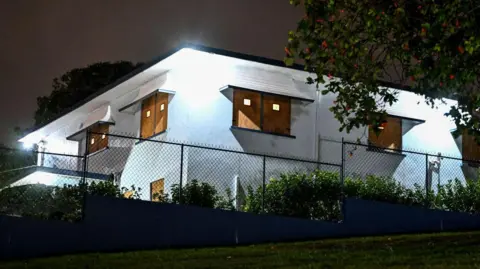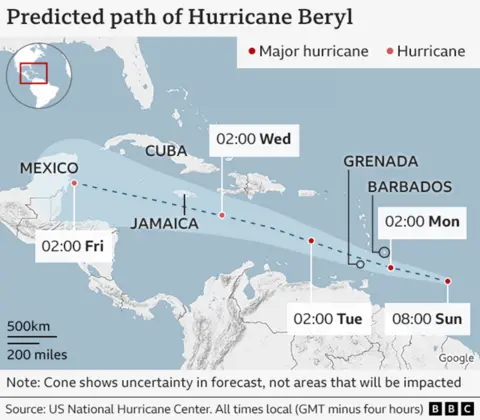By Ana Faguy, BBC News, Washington
 CHANDAN KHANNA/AFP via Getty Images
CHANDAN KHANNA/AFP via Getty ImagesCaribbean nations are warning residents to make emergency preparations with a powerful and potentially deadly hurricane strengthening further as it moves towards them.
Beryl, the first named hurricane of the season, is due to make landfall over a number of islands late on Sunday.
Forecasters said the hurricane is “extremely dangerous” and anticipate it developing into a category four storm – meaning it is predicted to have winds of up to 155mph (250km/h) and storm surge of six to ten feet (1.8-3 metres).
The major storm is expected to strengthen further as nears the Caribbean islands of Barbados, Dominica, Grenada and Martinique, among others.
“It’s rare to see a storm rapidly intensify this fast, this early in the season, in this part of the Atantic. Several islands across the Lower Antilles are facing an extreme risk to lives and property,” AccuWeather Lead Hurricane Forecaster Alex DaSilva warned.
People across the region are preparing by boarding up their homes, queueing for fuel at filling stations and stockpiling supplies and water in preparation for the storm.
 CHANDAN KHANNA/AFP via Getty Images
CHANDAN KHANNA/AFP via Getty ImagesIn an address to the nation on Saturday night, the prime minister of Barbados urged residents to look out for their friends, family and neighbours when the hurricane lands.
Forecasters say that Hurricane Beryl, which formed Friday night from a tropical storm, already has winds of 130mph as it heads towards the westerly Caribbean islands.
They predict that by the time the storm hits the Windward Islands – made up of Dominica, Martinique, St. Lucia, St. Vincent and the Grenadines and Grenada – there will be “hurricane-force” winds, a “life-threatening” storm surge and heavy rainfall.
Beryl is the second named storm of the season after Tropical Storm Alberto, which made landfall in north-east Mexico on 20 June. The heavy rains of that storm killed four people.
Barbados’ meteorological service issued warnings of power outages and flash flooding, as the eye of the hurricane is expected to pass about 26 miles (45 km) south of the island.
The storm is expected to drop up to six inches (15cm) of rain on Caribbean islands including Barbados.
People are boarding up their homes and thronging supermarkets and petrol pumps in the Barbadian capital, Bridgetown.
“We remain absolutely vigilant and need to take every precaution that is possible for ourselves, for our family and for our neighbours,” Barbadian Prime Minister Mia Motley said on Saturday.
In St Vincent and the Grenadines, Prime Minister Ralph Gonsalves urged the owners of supermarkets and petrol stations to extend their opening hours before the arrival of the hurricane, adding emergency shelters would open on Sunday evening.
Meanwhile, in a briefing shared online by the government of Dominica, meteorologist Ithoma James urged residents to be prepared, warning hurricanes could be “devastating”.

Hurricane season, which runs from 1 June to 30 November, is predicted to be a busy one this year, according to forecasters.
The National Oceanic and Atmospheric Administration (NOAA) issued its most startling warning to date about the current season. Forecasters said there could be up to 25 named storms in 2024.
Between eight and 13 of those storms could develop into hurricanes, the NOAA said.
Anywhere from four to seven of those storms could strengthen into category three – or more severe – hurricanes. That would be more than double the usual number.
Hurricane Beryl is now one of the earliest arrivals of the storms the NOAA warned of.
Michael Lowry, a hurricane expert, wrote on social media that it was “astonishing” to see a category three-or-more storm forecast “anywhere in the Atlantic, let alone this far east in the deep tropics” so early in the season.
“Only 5 major (category 3+) hurricanes have been recorded in the Atlantic before the first week of July. Beryl would be the sixth and earliest this far east in the tropical Atlantic.”
Hurricanes are categorised on a scale of one to five – with category five storms carrying the most extreme winds in excess of 155mph (250km/h). The stronger the hurricane, the more damage it is considered capable of inflicting.
In the 2023 hurricane season there were 19 named storms.






















Discussion about this post